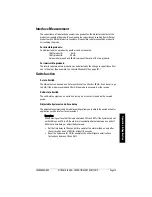
Page 14
SITRANS LC500 – OPERATING INSTRUCTIONS
7ML19985GE04
Oper
at
ion & Appl
icat
ion
3.
Upper Threshold Setting and Lower Threshold Setting activate and deactivate the
2-state output, and/or the solid-state output: the settings can be modified to adjust
the hysteresis (the window within which the probe is considered ‘covered’).
4.
The speed of response to activation and deactivation of the solid-state and/or
2-state output can be modified by Upper and/or Lower Threshold delays.
5.
The PV reading can be stabilized if necessary by applying Damping.
6.
Overfill or underfill protection can be set in the absence of those conditions by
applying the Delta Range Setting.
7.
Analog Fault Signalling (menu 08) and Digital Fault Signalling (menu 18) take
precedence over the threshold settings (menus 07 and 17).
Level Measurement
The continuous 4-20 or 20-4 mA signal is proportional to the surface level of the product,
with an accuracy of 0.1% of the actual measurement (for example, 1mm/m).
Typically, Lower Range Value (LRV - 0%) is set to 4 mA and Upper Range Value (URV -
100%) is set to 20 mA: but the reverse is possible if required. The measurement takes
place anywhere within that range. The LCD displays the value as mA, or pF, or percent,
depending on the setting for the transmitter variable (TV). If you are using HART, you have
the option to define the units.
P
Indicator - dynamic Primary Variable (units or % of range)
0-100%
auxiliary
power
pump
power
solid-
state
output
current loop connection
URV = 100%
Upper Threshold Setting = %
(activation hysteresis)
(deactivation hysteresis)
Lower Threshold Setting = %
LRV = 0%
USL
LSL
solid-
state
switch
output
or
2-state
mA output
Active Shield section
















































